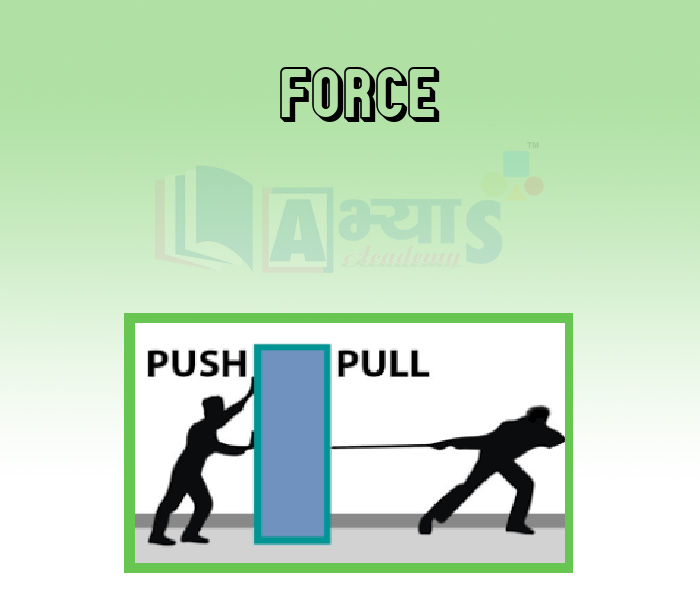Force


Force
In our everyday life, we observe that some efforts are required to put a stationary object into motion or to stop a moving object.
Force:
A pull or push over an object because of its interaction with other object is called force. For example:
1. To open a drawer, one has to pull it; and to close the drawer one has to push it. Thus, in both the conditions a person applies force by pull or push.

2. To kick a ball, one has to push it, i.e. a force is applied.

3. To ride a bicycle one has to push the pedal. In this condition, force is applied while pushing the pedal.

Direction and Magnitude of Force:
While plucking an apple from a tree we pull the apple towards ourselves. Hence we exert FORCE on that object. This also means that force has direction. Also, you push or pull an object gently or hard. This means force has a magnitude. Any action which causes pull, hit or push on a body is called force. Force cannot be seen but it can be judged only by the effects which it produces in various bodies around us.
The SI unit of force is Newton “N”.
Force can produce acceleration in the body on which it acts. When you apply the brakes in your bicycle, you are changing its velocity. Similarly, suppose you press the bulb of a dropper. You are producing a change in the shape of the bulb
State of Rest: An object is called in the state of rest when it is not moving. This means a stationary object is called in the state of rest. For example: a building, an electric pole, a ball kept over the ground and not moving, etc.
State of Motion: A moving object is called in the state of motion. For example – a moving car, a moving ball, etc. A force can speed up a moving object. Force can decrease the speed of a moving object. Force can stop a moving object. Force can change the direction of a moving object. Force can move a stationary object.
In which of the following cases the net force is zero ? a) A car drives around a circular race track at a constant speed b) A person holds the door to enter the room c) A ball, rolling across a grassy field, slowly comes to a stop | |||
| Right Option : B | |||
| View Explanation | |||
If a boat is moving along at constant speed, it may be assumed that--- | |||
| Right Option : D | |||
| View Explanation | |||
A body is moving with a velocity of 2 m/s and an acceleration (a) is needed to stop it within a distance Y. If the speed of the body is 4 m/s, the acceleration needed to stop it within the same distance (Y) will be | |||
| Right Option : D | |||
| View Explanation | |||
Students / Parents Reviews [20]
We started with lot of hope that Abhyas will help in better understnding of complex topics of highers classes. we are not disappointed with the progress our child has made after attending Abhyas. Though need to mention that we expected a lot more. On a scale of 1-10, we would give may be 7.

Manya
8thAbhyas institute is one of the best coaching institute in the vicinity of Ambala Cantt area. The teachers of the institute are well experienced and very helpful in solving the problems of the students.The good thing of the institute is that it is providing extra classes for the students who are w...

Aman Kumar Shrivastava
10thWhen I have not joined Abhyas Academy, my skills of solving maths problems were not clear. But, after joining it, my skills have been developed and my concepts of science and SST are very well. I also came to know about other subjects such as vedic maths and reasoning.

Sharandeep Singh
7thMy experience with Abhyas Academy has been very good. When I was not in Abhyas whenever teacher ask questions I could not speak it confidently but when I came in Abhyas, my speaking skills developed and now I am the first one to give the answer of teachers question.

Upmanyu Sharma
7thI have spent a wonderful time in Abhyas academy. It has made my reasoning more apt, English more stronger and Maths an interesting subject for me. It has given me a habbit of self studying

Yatharthi Sharma
10thMy experience with Abhyas is very good. I have learnt many things here like vedic maths and reasoning also. Teachers here first take our doubts and then there are assignments to verify our weak points.

Shivam Rana
7thAbhyas Methodology is very good. It is based on according to student and each child manages accordingly to its properly. Methodology has improved the abilities of students to shine them in future.

Manish Kumar
10thMy experience with Abhyas academy is very nice or it can be said wonderful. I have been studying here from seven class. I have been completing my journey of three years. I am tinking that I should join Abhyas Academy in tenth class as I am seeing much improvement in Maths and English

Hridey Preet
9thAbhyas is an institute of high repute. Yogansh has taken admission last year. It creates abilities in child to prepare for competitive exams. Students are motivated by living prizes on basis of performance in Abhyas exams. He is satisfied with institute.

Yogansh Nyasi
7thThird consective year,my ward is in Abhyas with nice experience of admin and transport support.Educational standard of the institute recumbent at satisfactory level. One thing would live to bring in notice that last year study books was distributed after half of the session was over,though study ...

Ayan Ghosh
8thBeing a parent, I saw my daughter improvement in her studies by seeing a good result in all day to day compititive exam TMO, NSO, IEO etc and as well as studies. I have got a fruitful result from my daughter.

Prisha Gupta
8thUsually we see institutes offering objective based learning which usually causes a lag behind in subjective examinations which is the pattern followed by schools. I think it is really a work of planning to make us students grab the advantages of modes of examination, Objective Subjective and Onli...

Anika Saxena
8thMy experience with Abhyas academy is very good. I did not think that my every subject coming here will be so strong. The main thing is that the online tests had made me learn here more things.

Hiya Gupta
8thA marvelous experience with Abhyas. I am glad to share that my ward has achieved more than enough at the Ambala ABHYAS centre. Years have passed on and more and more he has gained. May the centre flourish and develop day by day by the grace of God.

Archit Segal
7thIt was good as the experience because as we had come here we had been improved in a such envirnment created here.Extra is taught which is beneficial for future.

Eshan Arora
8thIn terms of methodology I want to say that institute provides expert guidence and results oriented monitering supplements by requsite study material along with regular tests which help the students to improve their education skills.The techniques of providing education helps the students to asses...

Aman Kumar Shrivastava
10thIt has a great methodology. Students here can get analysis to their test quickly.We can learn easily through PPTs and the testing methods are good. We know that where we have to practice

Barkha Arora
10thAbhyas institute is one of the best coaching institute in the vicinity of Ambala cantt.The institute provides good and quality education to the students.The teachers are well experienced and are very helpful in solving the problems. The major advantages of the institute is extra classes for weak...

Shreya Shrivastava
8thOne of the best institutes to develope a child interest in studies.Provides SST and English knowledge also unlike other institutes. Teachers are co operative and friendly online tests andPPT develope practical knowledge also.

Aman Kumar Shrivastava
10thAbhyas is a complete education Institute. Here extreme care is taken by teacher with the help of regular exam. Extra classes also conducted by the institute, if the student is weak.
